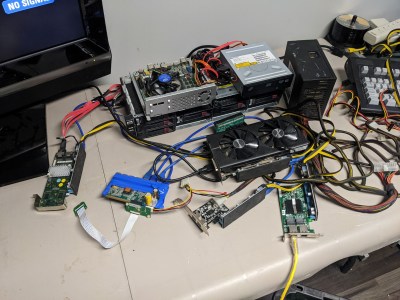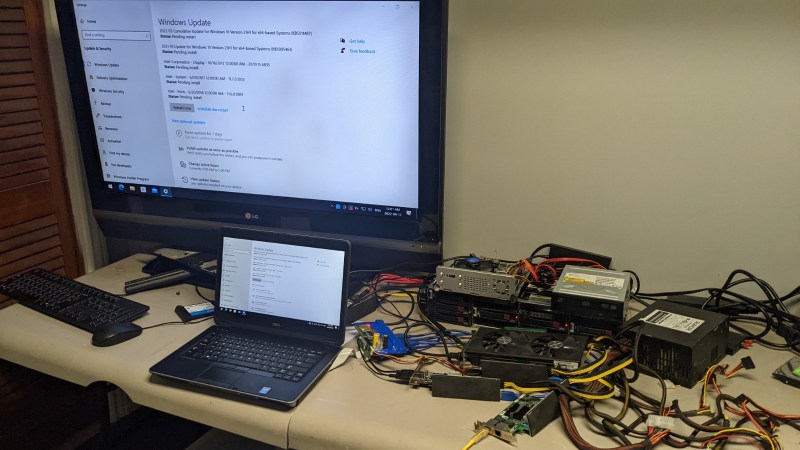Did you ever feel like your laptop’s GPU was sub-optimal, or perhaps that your laptop could use a SAS controller? [Rob Rogers] felt like that too, so now he has the only Dell Latitude business-class laptop that’s paired with an AMD RX580 GPU – and more. Made possible because of a PCIe link he hijacked from the WiFi card, he managed to get a SAS controller, a USB 3.0 expansion card, the aforementioned GPU and a dual-port server network adapter, all in a single, desk-top setup, as the video demonstrates.
First off, we see a PCIe packet switch board based on a PLX-made chip, wrapped in blue tape, splitting a single PCIe x1 link into eight. The traditional USB 3.0 cables carry the downstream x1 links to the four PCIe cards connected, all laid out on [Rob]’s desk. [Rob] demonstrates that all of the cards indeed function correctly – the SAS controller connected to a server backplane with whole 22 TB of storage in it, a few devices plugged into a USB 3.0 card, an Ethernet cable with an active link in the network card, and wrapping up the video showing 3DMark results of the RX580 clearly paired with the laptop’s mobile CPU. There’s four more spots on the PCIe switch card, so if you wanted to connect a few NVMe SSDs without the costly USB enclosures that usually entails, you absolutely could!
 Now, there’s a reason why we don’t see more of such hacks. This seems to be a Latitude E5440 and the card is plugged into a mini-PCIe slot, which means the entire contraption is bound by a single PCI-E Gen2 x1 link, heavily offsetting the gains you’d get from an external GPU when, say, gaming. However, when it comes to the types and amount of peripherals, this is unbeatable – if you want to add an external GPU, high-speed networking and a SAS controller to the same computer that you usually lug around, there isn’t really a dock station you can buy for that!
Now, there’s a reason why we don’t see more of such hacks. This seems to be a Latitude E5440 and the card is plugged into a mini-PCIe slot, which means the entire contraption is bound by a single PCI-E Gen2 x1 link, heavily offsetting the gains you’d get from an external GPU when, say, gaming. However, when it comes to the types and amount of peripherals, this is unbeatable – if you want to add an external GPU, high-speed networking and a SAS controller to the same computer that you usually lug around, there isn’t really a dock station you can buy for that!
Our collection of cool PCIe hacks has been growing, with hackers adding external GPUs through ExpressCard and mini PCIe alike, fitting PCIe slots where the factory refused to provide one, and extending the onboard M.2 slots for full-size PCIe cards. Nowadays, with these packet switches, it’s easy as ever to outfit any PCIe capable device with a whole slew of features – as this Raspberry Pi Computer Module motherboard with eleven PCIe slots demonstrates. Wonder how PCIe works, and why all of that is possible? We’ve written an entire article on that!
















What about the docking port?
Very few dock connectors expose the PCIe pins because very few docks have PCIe expansions in them.
The Thinkpad Advanced Dock (https://www.thinkwiki.org/wiki/ThinkPad_Advanced_Dock) is the last dock I can find that has a PCIe expansion in it.
Asus ROG XG Mobile and the Z13 use a proprietary pcie 3.0 x8 connector
ExpressCard needs to introduce a new version with a connector that spans the full width of the wider cards, incorporating USB 3.x and at least x4 PCIe 2.0, preferably 3.0. The 34mm wide portion could be left as-is for backward compatibility with old 34 and 54 mm ExpressCard devices.
I’d have the new ExpressCard slot with a hinged flap to guide 34mm wide cards into it so they’ll fit correctly into one side to hit the proper part of the connector. Old 54mm cards would push the flap aside and slide right in. New cards with the full width connector would do the same.
A company I expect would love to have such an interface is Framework Computer Inc. Having PCIe x4 3.0 + USB 3.x connections for all the swappable modules in their laptop would be so much better than the USB-C they currently use. That would also make it possible to have a very nice docking station with full size PCIe slots. Pop out the two rearmost modules and the dock plugs into them.
That is not a bad idea. If you have the choice try a laptop with dual x4 PCIe 3.0 m.2 slots, then you can get some decent bandwidth.
I’ve seen some m.2 2.5gbe cards I would like to internalize, but not with low profile connectors sadly.
On a similar note I’d love to see the CPU lanes to the m.2 slot on 12th gen heading to a secondary PCIe slot
You might want to take a look into Thunderbolt 4.
If your intent would be to standardize something with x8 or x16 bandwidth, that would be interesting. But ExpressCard is pretty much a legacy form factor at this point and it’s not likely to be resurrected in a market focused on thin and light laptops.
Thunderbolt doesn’t support bifurcation, but does support daisy chaining. What’s the difference? No idea
If you want a new card slot, make it compatible with mobile phones.
Start with a “standard size” phone, but the battery on the back is removeable.
Removing the battery also exposes your new slot, allowing more hardware to be sandwiched between phone and battery.
You want an SSD? A 3.5mm audio jack? Done. Hey, look at handheld transcievers from Yaesu etc and throw an SDR if you want.
Brilliant people should invest in a tripod. I thought for a moment this was recorded on a ship in rogue waves..
I would love to know more about the components used in this – The “PCIE splitter” seems like an interesting device that I wasn’t aware of. I have a situation where I need more slots (storage server, multiple JBOD controllers)
Its quite a rabbit hole I’ve fallen down myself, but there are single IC’s that play middle man and can share x1 lane with many, or split x16 lanes into smaller groupings for you, among many other interesting things, the PCIe spec is rather more complex than I appreciated before looking at these chips.
However with the silicon shortage they were unobtainable when I looked (which was ages ago now – that project idea got shelved and hasn’t been revisited yet)